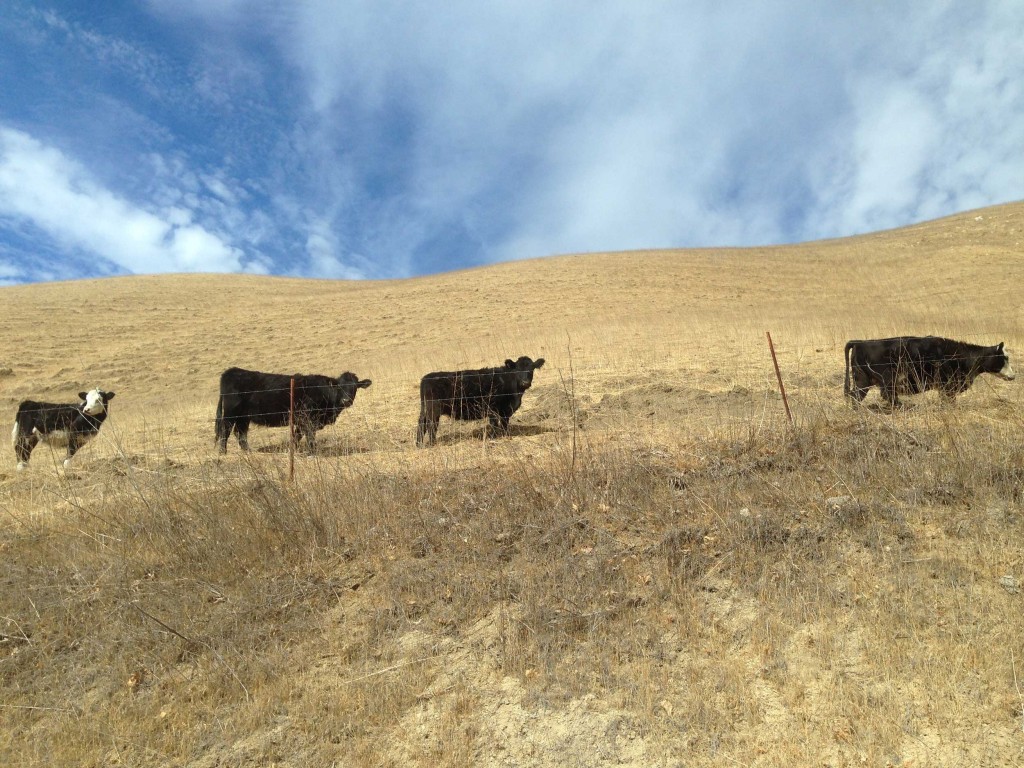By Alice Daniel
Rancher Gary Tarbell stands in the sale barn at the Tulare County Stockyard watching as cattle pass through a gate, into a ring and, one by one, are sold to the highest bidder.
“They’re going out of state, all these cattle,” Tarbell says. “There’s no water here.”
Just as farmers in the Central Valley are fallowing thousands of acres because of the drought, cattle ranchers are also cutting production. In fact, herd numbers nationwide are at their lowest since the 1950s, due in part to the Texas and California droughts.
“We had to cut way back,” Tarbell says. “I sold over half of my herd already because there’s no water on the ranch.”
hat’s not atypical, says Jon Dolieslager, owner of the Tulare County Stockyard. “Everybody here is selling, you know, probably double of what they would normally do just because they’re out of feed.”
Dolieslager is also the auctioneer. He takes a quick break from doing his auction cry — or, as some say, “cattle rattle” — and points to the pen behind him.
“We’ve probably got close to a thousand head of feeder cattle out there today that we have to sell,” he says. Those are drought numbers. On a sale day in a wet year, he would be selling anywhere from 300 to 500 feeder cattle — steers and heifers destined to go to feedlots.
Dolieslager says about a quarter of his customers, who come mostly from the San Joaquin Valley and the Central Coast, have quit ranching for now because their springs and wells have dried up and there’s no forage.
“They’re all completely out of feed and do not want to have to buy alfalfa because of the high cost of alfalfa, because of the high cost of water” to grow alfalfa, he says.
Outside the barn, Kyle Loveall is waiting his turn to sell off some yearling cattle. He’s the ranch manager for Elliott Land and Cattle.
“Typically, we wean our calves in early summer, run them over another year and sell them as yearlings,” he says. “Last year, we weaned them right away and sold them instead of keeping them because we didn’t have enough feed and water.”
He’s been a cowboy for 44 years, since the age of 14, and he’s never seen a drought like this.
“Last year, we fed almost all year-round,” he says. “It was a huge expense.” Just buying hay cost the ranch around $140,000, he says.
So far, he says, the water is holding on the ranch he manages. But he bought a water truck just in case the creek beds and wells go dry and he needs to haul in water. But that would be pricy. Cows drink a lot.
“Twenty-five to 35, 40 gallons a day,” he says. “Yeah, that’s a lot of water, times 400, that’s a lot of water.”
The ranch has reduced its breeding herd in the past three years by 60 percent, down to about 440 cows. And that means Loveall brought fewer calves to the auction this time.
“This is it,” he says. “This is basically our income for the year. Instead of 600 calves, we’re gonna sell 120 calves.”
Fortunately, beef prices are high.
“These cattle will bring a lot of money but it’d be nice if we had a thousand cows and the market was like this,” Loveall says.
Ranchers who are forced to sell will at least get a good price on their cattle, says Justin Oldfield, vice president of government affairs for the California Cattlemen’s Association. But, he adds, there’s a lot more to running a ranch than just buying and selling cattle.
It takes a lot of time to build up a herd, Oldfield says. Ranchers look for certain traits, including disposition.
“A lot of that work that you’ve put in, to putting together a cow herd that works for your ranch, goes out the window,” says Oldfield.
bout 30 minutes east of the Tulare County Stockyard, Sally Baker looks out at her ranch in the Sierra foothills directly below Sequoia National Park. She points to an empty streambed where her cattle used to drink. It’s not the only place on the ranch that’s dry, she says.
“Our springs have all dried up on the west side of our ranch, and we had a well on the north end of the ranch also go dry,” says Baker, a fourth-generation rancher.
When Baker’s dad died 20 years ago, she and her mom took over the ranch. Last year was particularly tough.
“We unfortunately had to sell about 50 cows, which broke my heart,” she says.
And they had to buy hay twice. But Baker says her mom grew up in the Depression, so she knows how to plan for the future.
“And so we were fortunate,” she says. “We had the means to do that. Unfortunately, a lot of ranchers didn’t have a reserve and had to sell off a lot of their stock.”
Her mom, Sally Dudley, can see their cattle from her living-room window. Dudley has lived on the ranch for more than 60 years and is worried about the drought.
“If it continues it’s really going to be disastrous, because you know the water table is dropping and that’s going to affect all of us,” she says.
She doesn’t do much of the physical labor anymore, but she still keeps the ranch’s books.
“You try to be frugal,” she says. “You know, you just save for a rainy day.”
Or, in her case, a really long drought.



